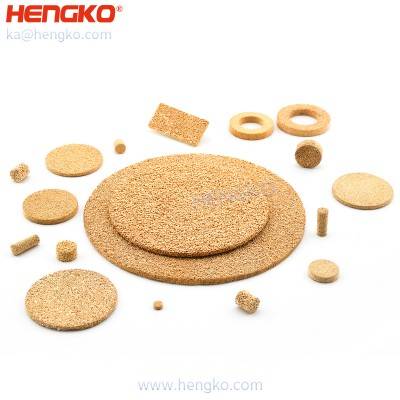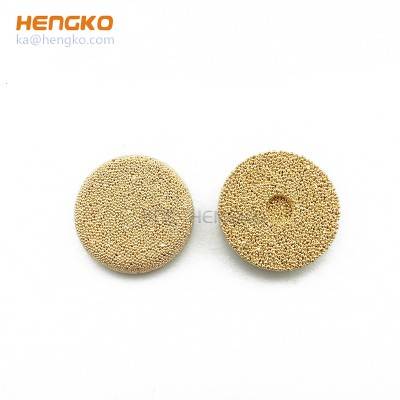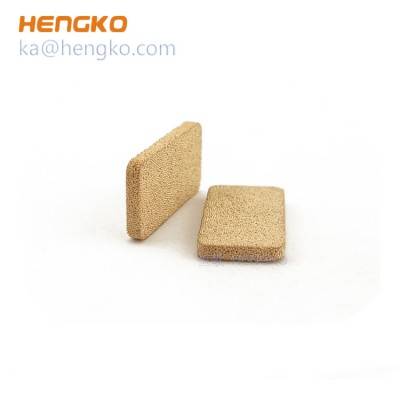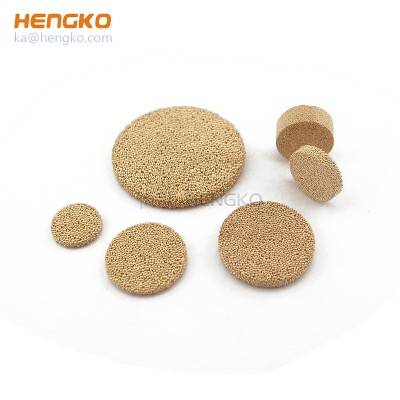-

Metal powder sintered porous porosity bronze 316 stainless steel micro filters discs
The bronze porous sintered filter element is made of copper alloy powder sintered at high temperature. It has high filtration precision, good air permeabili...
View Detail -

Personal customization 15 45 90 micron powder sintered brass bronze porous metal oil fi...
HENGKO manufactures filter elements in a broad range of materials, sizes, and fittings so they can be easily specified with the characteristics and configura...
View Detail -

porous metal filter disc square strainer micron sintered bronze filter sheet
HENGKO manufactures filter elements in a broad range of materials, sizes, and fittings so they can be easily specified with the characteristics and configura...
View Detail -

sintered metal filter disc for wastewater treatment, 5 20 micron 304 316L stainless ste...
Depth filter sheets are used to remove particles from liquids. This means that liquids can be clear-, fine- or sterile-filtered. Filter sheets are ideal for ...
View Detail
⭐ Key Features of Stainless Steel Porous Frits
1. Uniform and Precise Pore Structure
Stainless steel porous frits are manufactured using advanced powder metallurgy and sintering processes,
allowing for extremely consistent pore size distribution.
This ensures accurate, repeatable filtration performance, which is critical in applications like gas sampling,
HPLC systems, and fine chemical processing where precision is vital.
2. High Mechanical Strength and Durability
Due to the solid metal structure formed during sintering, these frits can withstand high pressure, vibration,
and mechanical stress without cracking or deforming.
They are ideal for demanding environments like industrial filtration systems, high-pressure reactors,
or sensor protection in harsh conditions.
3. Excellent Corrosion Resistance
Made from stainless steel grades such as 316L, these frits resist corrosion from acids, alkalis, solvents,
and other aggressive media. This makes them suitable for chemical, pharmaceutical, and petrochemical industries,
where exposure to harsh substances is common.
4. High Temperature Resistance
Stainless steel porous frits can operate continuously at temperatures up to 600°C or more, depending on
the alloy used. Unlike plastic or polymer filters, they maintain structural and filtration integrity under thermal cycling
and extreme heat, making them suitable for processes involving hot gases or sterilization.
5. Reusable and Easy to Clean
These frits are designed for long-term use and can be cleaned using backflushing, ultrasonic cleaning, steam sterilization,
or chemical soaking. This reusability reduces replacement costs and downtime in industrial operations.
6. Stable and Non-shedding Structure
Unlike fiber or ceramic filters that may degrade over time, sintered stainless steel frits are solid and do not release particles
into the media. This makes them ideal for sensitive systems such as precision instruments, gas analyzers, and sterile environments.
7. Customizable in Shape, Size, and Micron Rating
You can design frits to meet specific dimensional and filtration requirements — including discs, tubes, cones, or special geometries.
Micron ratings can range from sub-micron (0.5 μm) to coarse (100+ μm), offering great flexibility across different applications.
8. Broad Chemical Compatibility
Stainless steel is chemically inert to a wide range of substances, allowing frits to be used with gases, organic solvents,
water-based solutions, and more — all without compromising material integrity or contaminating the filtered media.
Applications of Porous Stainless Steel Frits
-
1.Gas and Liquid Filtration
Used in filtration systems to remove particulates from gases and liquids in industrial processes. Ideal for applications requiring clean, particle-free output, such as in compressed air systems or hydraulic circuits. -
2.Gas Diffusion and Sparging
Stainless steel frits are often used as spargers or diffusers to distribute gas evenly into liquids for chemical reactions, fermentation, or water treatment. Their uniform pore structure ensures fine bubble generation for efficient gas-liquid contact. -
3.Chromatography Systems (HPLC, GC)
Frits serve as in-line filters or column-end supports in HPLC and gas chromatography to prevent solid particles from entering the column and to evenly distribute the sample and mobile phase. -
4.Sensor Protection
In environmental and industrial sensors, frits are used as protective filters to shield sensing elements from dust, moisture, and chemicals while still allowing gas or air flow to pass through. -
5.Catalyst Support
The porous structure can hold or immobilize catalysts in chemical reactors, enabling uniform flow and reaction efficiency. These are often used in gas-phase or liquid-phase catalytic processes. -
6.Flow Restriction and Damping
Stainless steel frits can act as flow restrictors or dampers to control gas or liquid flow rates in instrumentation and analytical equipment. Their predictable pore size allows for precise flow control. -
7.Vacuum and Degassing Systems
Used in degassing chambers and vacuum systems to filter out vapors and particulates while maintaining system integrity under low pressure. -
8.Sample Preparation and Laboratory Filtration
Commonly used in laboratory settings to filter, separate, and prepare samples for analysis. Their chemical compatibility and heat resistance make them versatile for lab equipment. -
9. Fluid Sampling and Inline Monitoring
Installed in pipelines or sampling systems to ensure clean and accurate sample extraction from process streams, especially in oil, gas, and water quality testing. -
10.Medical and Pharmaceutical Equipment
Used in sterile filtration, cleanroom environments, or drug delivery systems due to their biocompatibility, sterilizability, and particle retention capabilities.
Frequently Asked Questions
1. What is a porous metal frit and how does it work?
A porous metal frit is a filter component made from sintered metal powders, typically stainless steel, bronze, or titanium. During the sintering process, metal particles are bonded together under high temperature without melting, creating a rigid structure with interconnected pores.
These pores allow fluids or gases to pass through while trapping solid particles, making them ideal for filtration, diffusion, pressure equalization, and flow control in various industrial applications. Their strength, uniformity, and chemical resistance make them far superior to traditional filter media like mesh or polymers in demanding environments.
2. What are the advantages of using stainless steel porous frits over other materials?
Stainless steel porous frits offer several key advantages:
-
*High mechanical strength – suitable for high-pressure and vibration-prone environments.
-
*Excellent corrosion resistance – ideal for harsh chemicals, solvents, and outdoor use.
-
*High temperature tolerance – maintains stability even above 600°C.
-
*Reusable and cleanable – can be backflushed, ultrasonically cleaned, or sterilized.
-
*Non-shedding structure – unlike fiber or mesh filters, they don’t release particles.
Compared to ceramic, polymer, or glass frits, stainless steel versions last longer, are more versatile, and offer a superior total cost of ownership.
3. What pore sizes are available for metal frits?
Porous metal frits can be manufactured in a wide range of pore sizes, from sub-micron levels (0.5 µm) to coarse pores exceeding 100 µm. The selection of pore size depends on your application:
-
*0.5–5 µm: fine filtration, sterilizing gas, HPLC protection
-
*5–20 µm: liquid filtration, gas sparging, flow control
-
*20–100+ µm: coarse separation, structural support
-
Custom pore sizes and porosity levels can also be tailored based on required flow rate, filtration efficiency, and mechanical strength.
4. Where are porous metal frits commonly used?
Porous metal frits are widely used across multiple industries:
-
*Pharmaceutical and biotech – sterile filtration, chromatography, gas diffusion
-
*Chemical and petrochemical – catalyst support, inline sampling, gas sparging
-
*Environmental monitoring – sensor protection, air quality testing
-
*Food and beverage – gas dispersion, sanitary filtration
-
*Industrial automation – flow control, damping, backpressure regulation
They are essential wherever durable, high-precision filtration or flow control is required.

5. Can porous metal frits be reused and how are they cleaned?
Yes, one of the biggest advantages of porous stainless steel frits is that they are reusable and easy to clean. Cleaning methods include:
-
*Backflushing with air or solvent
-
*Ultrasonic cleaning to remove embedded particles
-
*Chemical soaking using acids or solvents, depending on the contamination
-
*Steam or autoclave sterilization for sanitary applications
Proper maintenance significantly extends the life of the frit, making it a cost-effective solution over time.
6. Are porous metal frits customizable?
Absolutely. Manufacturers like HENGKO offer full OEM/ODM customization services, allowing you to specify:
-
*Pore size and porosity level
-
*Shape and dimensions (discs, tubes, cones, cups, flanges, etc.)
-
*Material type (316L stainless steel, titanium, Hastelloy, etc.)
-
Micron rating and flow rate targets
This ensures optimal performance and integration into your system or device.
7. How do porous frits differ from mesh or perforated metal filters?
While mesh or perforated metal filters rely on surface filtration, porous metal frits offer depth filtration. That means:
-
*Contaminants are trapped within the depth of the material, not just on the surface.
-
*They provide higher dirt-holding capacity and better particle retention.
-
*Their structure is more rigid, durable, and resistant to deformation under pressure.
For critical applications requiring high precision, longevity, and minimal maintenance, porous frits are the superior choice.
Need a Custom Porous Metal Frit? Let’s Build It Together.
Whether you require precise pore size, unique shapes, or extreme environmental durability
— HENGKO specializes in custom porous frit solutions tailored to your exact application.
Contact us today at ka@hengko.com to discuss your specifications and receive expert support from our engineering team.
Your custom frit, your performance advantage — made by HENGKO.









